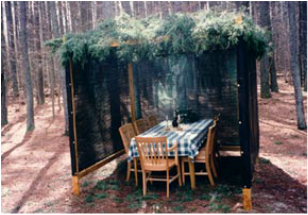Feast of Tabernacles
Rituals remind us of God’s saving work in this story we’re a part of, and give a way for our children to become active participants in that story. This is the season of the Jewish Feast of Sukkot, or Feast of Tabernacles. This is a pilgrimage festival, when those who could traveled to Jerusalem to celebrate together. They did this to remember the 40 years the people of God spent in the wilderness. They didn’t have permanent houses like we do; instead, they had homes they could take apart and rebuild somewhere else when it was time to move. God helped them know where to go, gave them food to eat, showed them how to live in peace with each other, and protected them. So at Sukkot, we build our own “tents” to remember how God protects us and takes care of us. We remember to trust God. And we are reminded of how people long, long ago in this story lived.
Do It
Built your own Sukkah (tent). Traditionally, this would be done outside, but depending on your climate you may want to build it inside or on a porch. You can use anything you want in your house - tables, chairs, ladders, a large box or blankets. Then make a roof out of nature - branches, leaves, long grasses, or whatever else you can find in your area. Decorate the inside with whatever your child finds beautiful - drawings, ornaments, lights, elements of nature. Make it a home with pillows, blankets, and other things your child thinks belong in a home. Then enjoy your tent. Invite guests to come in. Read the story of wandering in the wilderness from your Bible or a children’s story Bible. Sing songs or pray together. Eat meals or snacks in it. If your child is old enough, let them sleep in there. This is a playful way to be part of God’s story!
Built your own Sukkah (tent). Traditionally, this would be done outside, but depending on your climate you may want to build it inside or on a porch. You can use anything you want in your house - tables, chairs, ladders, a large box or blankets. Then make a roof out of nature - branches, leaves, long grasses, or whatever else you can find in your area. Decorate the inside with whatever your child finds beautiful - drawings, ornaments, lights, elements of nature. Make it a home with pillows, blankets, and other things your child thinks belong in a home. Then enjoy your tent. Invite guests to come in. Read the story of wandering in the wilderness from your Bible or a children’s story Bible. Sing songs or pray together. Eat meals or snacks in it. If your child is old enough, let them sleep in there. This is a playful way to be part of God’s story!

Pray It
God, thank you for all you have done for us. Thank you for bringing your people out of Egypt, protecting and providing for them in the wilderness, and letting us become part of your big story. In Jesus’ name we pray, Amen.
God, thank you for all you have done for us. Thank you for bringing your people out of Egypt, protecting and providing for them in the wilderness, and letting us become part of your big story. In Jesus’ name we pray, Amen.
Extras
Get a more full explanation of Sukkot: http://en.wikipedia.org/wiki/Sukkot
If your child really gets into the Sukkot mindset, here are some more ideas for activities you can do: http://www.chabad.org/kids/article_cdo/aid/3_54746/jewish/Sukkot.htm
A good, more scholarly but still readable article about the importance of ritual in family life, from a Mennonite Brethren perspective: http://www.directionjournal.org/19/1/rituals-and-family-strength.html
Get a more full explanation of Sukkot: http://en.wikipedia.org/wiki/Sukkot
If your child really gets into the Sukkot mindset, here are some more ideas for activities you can do: http://www.chabad.org/kids/article_cdo/aid/3_54746/jewish/Sukkot.htm
A good, more scholarly but still readable article about the importance of ritual in family life, from a Mennonite Brethren perspective: http://www.directionjournal.org/19/1/rituals-and-family-strength.html

